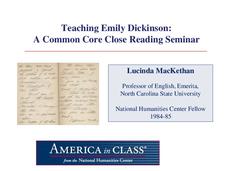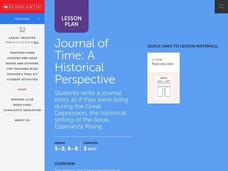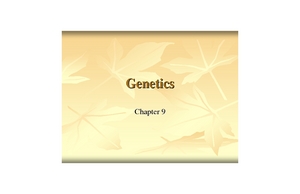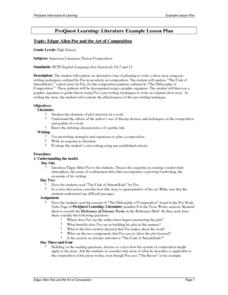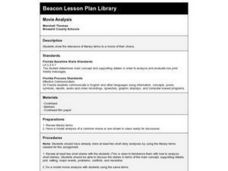National Humanities Center
Teaching Emily Dickinson: A Common Core Close Reading Seminar
Three of Emily Dickinson's poems, "I like to see it," "Because I could not stop for Death," and "We grow accustomed to the Dark," provide instructors with an opportunity to model for class members how to use close reading strategies to...
Curated OER
To the North: A Black Family Leaves Arkansas to Find Work in Michigan
Upper elementary and middle school scholars study the economic factors that caused so many Arkansans to migrate to different parts of the country looking for work. Use this history lesson plan to help your charges gain a better...
Curated OER
Journal of Time: A Historical Perspective
Analyze the setting behind the Great Depression in California with Pam Munoz Ryan's Esperanza Rising. Middle schoolers assess the protagonist during her coming-of-age moments, while migrant workers manage the hardships of the...
Curated OER
Mark Twain: Straddling the Civil War
Mark Twain's life, politics, writing, and role as a mirror of pre- and post-Civil War American culture are the focus 11th and 12th graders in this section from an expansive author study. A critical writing assignment comparing Twain...
Curated OER
A Trip Back in Time: Missouri quarter reverse
I love time capsules. After reviewing elements of pioneer life, your class will create a time capsule that would have belonged to a pioneer in the 1830s. Each person must write a description of each item they would have brought and why...
Curated OER
Elements of a Short Story
Students analyze elements of a short story by working together. In this literature lesson plan, students analyze short stories. They use the TI Navigator Application to write their findings.
Curated OER
English
Students view examples of movies and create a movie trailer for an original thematic movie. In this fiction elements lesson, students complete creative event entries and view an abbreviated movie trailer from Alice. Students watch The...
Curated OER
Story Scrapbook
Students develop a comparison worksheet using one non fiction book and one fiction book they have read to be put into a class scrapbook. In their comparison students must have title, author, point of view, setting, characters, and other...
Curated OER
Genetics
Students identify literary elements in each selection while learning about diversity and the struggle for equality in the United States. They use their knowledge to express the emotion and key literary elements in each piece through...
Curated OER
Predictions, Predictions, and More Predictions
Third graders pose questions about the subject of a short story based on the title and cover illustration; then read the story and determine if their questions actually pertained to the story line, and, if so, how the story answered the...
Curated OER
The Art of Description
Students apply descriptive language to identify the five elements of art and the basic lines, geometric shapes, and angles in Marie Hull's, Sharecropper. They explain how the elements of a piece of work contribute to the story it tells....
Curated OER
Write Your Own Folk or Fairy Tale
Students analyze folk and fairy tales. In this language arts lesson, students discuss the elements of a tale determining what the differences are between folk and fairy tales. Students then write their own tales using the graphic...
Curated OER
Nature’s Fury—Myths and Drama
Fifth graders explore the elements of theatre. For this dramatic performances lesson, 5th graders discuss the structural elements of theatre and dramatize "The Origins of the Season," an explanation myth.
Curated OER
And Then What Happened?
Students analyze paintings by using verbs, adjectives, and nouns. In this visual arts lesson, students view a painting of a storm and a calm sky. Students use various verbs and adjectives to discuss the characteristics of each painting....
Curated OER
Rebus Writing
Fifth graders write rebus stories using technology. They share the rebus stories with younger students
Curated OER
Clerihew Dances I
Third graders demonstrate locomotor movements and define non-locomotor movement. They discuss a story and perform a "name" movement.
Curated OER
Edgar Allen Poe And The Art Of Composition
High schoolers evaluate several works by Edgar Allen Poe based on the criteria in his essay, "The Philosophy of Composotion" Their analysis is documented using a graphic organizer. Learners begin the pre-writing process for their own...
Curated OER
Presidential Election 2004: Analyzing the Attack Ads
Students view and text the text of presidential election advertisements in 2004. Using the ads, they analyze them and check the validity of the statements made. They answer discuss questions for each ad and share them with the class.
Curated OER
Break Down
Fourth graders apply their understanding of the elements of plot structure and conflict to cooperatively create storyboards and speak effectively as they present their products. They create storyboards for some of the classic Disney...
Curated OER
Movie Analysis
Fourth graders discuss main concept, supporting details, plot, setting, major events, problems, conflicts, and resolution in two short stories. They apply these terms to a movie of their choice. They compare analysis of movies to...
Curated OER
What's the Problem? Exploring Conflict in "On the Sidewalk Bleeding"
Students use the story 'On the Sidewalk Bleeding' to analyze the various conflict types found in literature. In this conflict lesson, students view a PowerPoint about the story and identify the four types of conflict. Students identify...
Curated OER
Reading the Movies: Another Approach To Teaching Critical Thinking Skills And Writing
Students explore the elements of film to analyze character, action, and the themes in the movie, "Quiz Show." The lesson encourages students to make personal connections and real life applications as they view the movie, critically.
Curated OER
Reader's Theater with a Twist
Second graders create a Reader's Theater script. For this reader's theater lesson, 2nd graders create their own script of a story in groups. They make props and act them out on FlipVideo and voice thread.
Curated OER
Things Aren't Always What They Seem
Young scholars use video and the Internet to make predictions, draw conclusions, determine conflict and point of view while reading a short story. In this short story analysis instructional activity, students watch a related video and...


